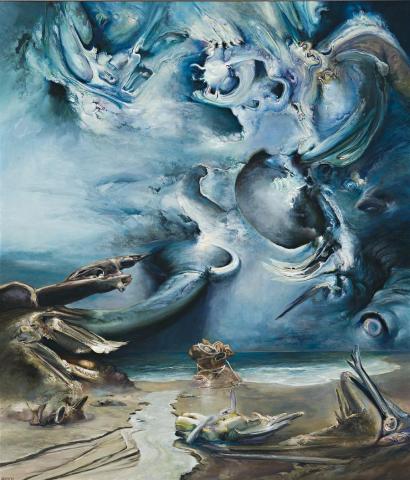NIGHTFALL ON A TENTATIVE YESTERDAY, 1989
JAMES GLEESON
oil on canvas
179.0 x 154.0 cm
signed and dated lower left: GIeeson ‘89
signed and titled verso: “NIGHTFALL ON ATENTATIVE YESTERDAY” James Gleeson
Lauraine Diggins Fine Art, Melbourne (label attached verso)
Private collection, Melbourne
'By far the greater amount of material with which the mind is stored is never woven into the fabric of reason or imagination, and its existence is only noticed when it breaks temporarily from its prison to be embodied in our dreams and phantasies. This indicative material flung up out of our subconscious is the store house of Surrealism.'1
The concept of 'reason' and 'logic' and its unravelling in order to reach a higher truth recurs frequently in texts on Surrealist art. In his famous 'Manifeste du Surrealisme' Andre Breton explained the movement as: 'pure psychic automatism by which it is intended to express, either verbally or in writing, the true function of thought. Thought dictated in the absence of all control exerted by reason, and outside all aesthetic or moral preoccupations.'2 The belief in stripping back reason naturally lead to the invocation of dreams and dream sequences throughout Surrealist art, as though dreaming and nightfall provide the pathway to the unconscious mind. Indeed dreams and their underpinnings in Greek mythology are ever present throughout Gleeson's painting. The illusion to night's cloak of darkness in the title, Nightfall on a Tentative Yesterday, typifies this sense of the unconscious being unleashed in the very dreams and phantasies the artist alludes to in the above quote. In the presence of the unconscious the rationality of yesterday and day to day life fade away to nothingness.
James Gleeson was without doubt Australia's leading surrealist painter and he remained steadfast in his commitment to the philosophy underpinning this international movement throughout his career. The1980s were a particularly creative and productive period for Gleeson and Nightfall on a Tentative Yesterday is a key work from this time featuring the mutable, transforming landscape as it merges with the ocean. The sea has been a poignant symbol of the unconscious since Greek mythology and the organic merging of body forms and landscape in this work hark back to the mutable shape changing sea god Proteus, son of Poseidon. His inextricable link to the ocean made him a symbol also of the unconscious. In fact, Carl Jung defined Proteus as the personification of the unconscious. Gleeson most certainly understood these links between psychoanalysis and mythology and throughout this series of works we find rich panoply of shape changing, protean forms in the process of transformation as they merge with sea, sky and land.
1. Gleeson, J., in Free, R., James Gleeson: Images from the Shadows, Craftsman House, Sydney, 1993, p. 112. In Free, op. cit., p. 8
LARA NICHOLLS
